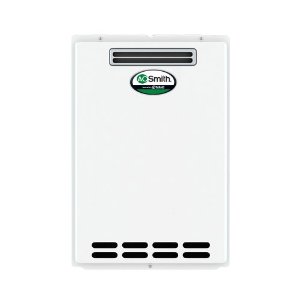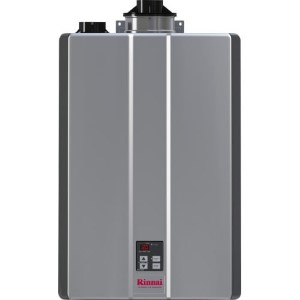- Home
- AO Smith Water Heaters Review
- AO Smith Tankless
AO Smith Tankless
Water Heaters
Review and Buying Tips
AO Smith tankless water heaters are built with the condensing and non-condensing technology for on-demand water heating in residential and light commercial applications. Find out which ones are the best for you, and what are the top features and advantages.
Advantages and benefits
AO Smith tankless (available on amazon.com) are on-demand water heaters that come with many great benefits, such as an endless and continuous supply of fresh hot water, on-demand, anytime, and almost anywhere. Tankless from AO Smith are high-efficient and ultra-low NOx. They include advanced safety features such as the modulating gas valve, diagnostics system, AFR sensor to ensure proper combustion, internal anti-freeze system, anti-scale technology, and others.
AO Smith tankless water heaters are designed small, compact, and wall-hanging, which saves on floor space, and with its power-venting and sealed gas combustion allows more flexibility and installation.
All the appliances use natural gas or propane for high-efficiency water heating, making some models Energy Star approved and eligible for the federal tax credit and utility rebates.
A great design allows them to supply enough hot water from small homes (apartments, condos, cottages) to larger ones with several bathrooms or applications working simultaneously. Which one you choose depends on your budget, house and family size, installation options, and your preference. Check out our article on how to select a tankless water heater for more info.
Features

Tankless water heaters from AO Smith are designed as indoor and outdoor units, where indoor units use the power or power direct (optional) vent system to move by-products of combustion out. The outdoor models are ventless; the fan and air passages are enough to discharge the gases and get the fresh air for combustion.
Strong heat exchangers
Some residential tankless heaters, such as models from the 510 and 540 series, utilize a primary commercial-grade heat exchanger made of thick HRS 35 copper alloy, which provides more strength, resistance, and longer life than the standard type. The secondary heat exchanger, which is found only on condensing models, is made of stainless steel providing better corrosion resistance and longer life.
Modulating gas valve
Both condensing and non-condensing water heaters are fully modulating, which means that the burner works in a range from its minimum to its maximum power, so the temperature is based on the existing water flow. This is what provides more comfort during the shower.
Electronics
The remote control is a standard feature and is used to control the hot water temperature, and it shows the error codes when the problem occurs. In some models, it is built-in, while with others, it is provided. For additional convenience, the power cord is also included, which saves time during the installation.
The units have advanced electronics that provide a better performance, accuracy, and easier troubleshooting. If the remote control is installed and there is a problem with the unit, the numerical error code will display. Use the troubleshooting guide to fix the problem.
Venting
All the indoor models use the vent system, which consists of the power vent and 4" stainless steel vent pipe, Category III, which brings excellent flexibility in moving the flue gases out safely. The installation can be horizontal or vertical and with a maximum length of 50 ft. This applies to non-condensing models, while condensing uses PVC.
The outdoor models do not require such venting systems because they are vent-less, and a fan is used to force the gases out.
Capable of delivering hot water to high demanding applications
For larger applications with the high hot water demand, you can use an Easy-Link system to connect up to four identical units into one system, while with the Multi-Unit system, you can combine up to 20 units. From residential models, this is possible only on the 510 and 540 series.
Safety
AO Smith tankless water heaters are very safe. They safely transfer the by-products of combustion through the venting system, use the sealed combustion chamber for gas combustion, including the AFR or Air-Fuel Ratio sensor for the proper combustion and reduced gas emission.
The freeze protection protects the unit during the cold freezing periods while the elements such as the hi-limit switch and overheat cutoff fuse protect the units and components from overheating. Other safety features include the flame sensor, which shuts the unit off when the flame is extinguished, and a flue backdraft pressure switch, which shuts the unit off if something is wrong with the flue vent.
Related: Rinnai RUR98
An overview of AO Smith tankless water heaters
There are two main types of AO Smith tankless water heaters: non-condensing and condensing, both coming from the ProLine XE series, promoted as "BEST".
Non-condensing water heaters
AO Smith tankless water heaters are also available as non-condensing and high-efficient, but with a lower energy factor than the condensing units, reaching energy factors of 0.81-0.82.
The models are as follows:
- Series ATI/ATO 110/U/C* - with the maximum water flow of 6.6 gallons per minute, the smallest tankless water heaters from AO Smith are used for heating water in homes with one to two baths (depends on the climate or groundwater temperature). These models are recommended for smaller houses, apartments, condos, and cottages. They come with a maximum power of 140,000 BTU and an energy factor of up to 0.81.
- Series ATI/ATO 310/U/C* is used to supply hot water to two to three bathrooms due to its maximum power of 190,000 BTU, maximum water flow rates of 8 GPM, and an energy factor of 0.82.
- Series ATI/ATO 510/U/C* is powered by an eco-friendly gas burner that can provide up to 199,900 BTU of power and a maximum water flow rate of 10 GPM, which makes it ideal for homes with two to four bathrooms. These models can combine more units into one system if the demand for hot water is higher.
*ATI models are indoor while ATO models are outdoor, using a power or power direct venting system.
Models such as ATI/ATO 110, 310, and 510 are non-condensing and low NOx water heaters that come with the remote controller.
Models such as ATI/ATO 110U, 310U, and 510U are non-condensing and ultra-low NOx water heaters that utilize an integrated temperature controller and two-pipe vent system for indoor models, while the controller for outdoor ventless models is provided.
AO Smith models ATI 110C, 310C, and 510C are indoor and non-condensing that utilize a built-in temperature controller and concentric or one-pipe venting system for easier installation. They are also ultra-low NOx.
Note: All indoor, non-condensing tankless water heaters from AO Smith must use category III stainless steel venting.
Condensing type
Condensing water heaters from AO Smith are also designed for indoor (ATI models) and outdoor (ATO models) installation.
- 140H series - used for 1.5 to 2.5 bathrooms (maximum water flow rates are up to 6.6 GPM).
- 240H series - used for 2.5 to 3.5 baths (maximum water flow rates are up to 6.6 GPM).
- 340H series - used for 2.5 to 3.5 baths (maximum water flow rates are up to 8 GPM).
- 540H series - used for 2.5 to 4.5 baths (maximum water flow rates are up to 10 GPM). It uses an Easy-Link system to connect up to 4 units, or 20 units, with the multi-unit controller if the demand is higher.
If you live in a region with hard water and it causes frequent problems with the sediment and limescale buildup, you should consider getting a unit with the X3 Scale prevention technology.
There are three indoor models to choose from that are Energy Star approved, condensing, and include a recirculation pump for faster hot water delivery. The maximum power is in the range of 160,000 to 199,000 BTU, and all the models heat water with high efficiency of 0.93.
Models that are built for indoor installation (ATI models) come with integrated controls and diagnostics systems, also a two-pipe vent system, while outdoor models (ATO) come with the remote controller and ventless configuration.
The main difference between condensing and non-condensing heaters is in the technology used to heat water. Condensing water heaters are much more efficient since water is preheated in the heat exchanger from flue gases, which increases the energy factor to a high 0.95.
AO Smith tankless water heaters with condensing technology are more expensive but have the lowest operating costs and reduced gas emissions. They use stronger and more durable materials, such as thicker copper for the primary exchanger and stainless steel for secondary HE, or the advanced burner for low NOx emission. Use this article for a detailed review of condensing water heaters.
Best of AO Smith
The best model from Proline XE tankless and non-condensing series is ATI-510C that features concentric venting and ultra-low NOx gas burner. This model comes with the highest BTU rating and water flow rate. If the demand for hot water is higher, it can use an Easy-Link cable to connect up to 4 units, while when using the Multi-Link, it can connect up to 20 units and operate as an integrated system.
From the condensing series, choose a model ATI-540P-N, which comes with an integrated recirculation pump so hot water can be delivered fast through the plumbing with a pipe length of up to 500 feet. It can also use an Easy-Link cable and Multi-Unit System to increase the flow rate substantially for larger applications.
Summary
AO Smith tankless water heaters are ideal for those looking for on-demand fresh hot water delivery with an endless supply without occupying too much living space. It is excellent for homeowners looking to heat potable water directly or indirectly, using it in radiant floor heating, recirculation, or combined with space heating.
No matter which one of the reviewed AO Smith tankless models you select, you will save; energy, water, space, and money. Like most tankless water heaters, they last long and are backed by the manufacturer for 15 years.
Related
Leave a Comment
- Home
- AO Smith Water Heaters Review
- AO Smith Tankless


